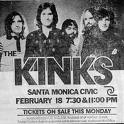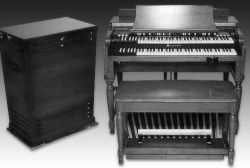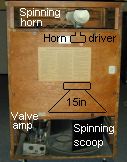It is essential to have an historical perspective of live music amplification including the trends that shaped how amplified music is heard if we wish to be in command of how we manage it. The following essay is an abridged overview using selected points from within a large complex history.
When listening to a symphony orchestra in a concert hall, we experience hearing real musical instruments. But the majority of live music is amplified through speakers. We often forget that it is not the instruments and voices we are hearing, but a vibrating piece of paper, with an attached coil of wire in a magnetic field. Instruments and voices are shaped by the sound of the speaker. The speaker becomes the instrument. In the words of Marshall McLuhan "The medium is the message".
Musical instruments became amplified the moment amplifiers became available By 1930, many variations of amplifying guitars were being developed. The Hawaiian guitar was possibly the first instrument uniquely created by amplification. The fusion jazz guitar style of Django Reinhardt inspired many, including Les Paul the father of the solid body guitar and over-dub recording. After the 2nd world war, manufacturers of musical instrument amps and electric guitars flourished.

From the early 1950s, electric guitar characterised the sound of Rock'n'Roll , Bill Haley, Buddy Holly, Elvis Presley etc. Up till the early 1960s the majority of live pop bands were typified by how the Beatles performed, Small combo 30 to 60 Watt valve amps (2 x 12in speakers) and a separate PA for voice. When performing to large audiences, extra mics were placed in front of the small guitar amps.
"You Really Got Me". The breakthrough that transformed rock music was when Dave Davies purchased a little green Elpico amp from a radio spares shop. He sliced the speaker cone with a razor blade, then slaved his Epico into a Vox AC-30. (1964) The Kinks hit song "You Really Got Me" became the blueprint sound of electric guitar that transformed the industry forever.

The Kinks were not the first band to drive guitar amps into overdrive, but the song "You Really Got Me" dominated the air waves and caused an extreme reaction. The older generation that represented the incumbent Victorian values of the past, which included parental, educational, management and political establishment, plus the elite class of the electronic engineering fraternity that included the radio, TV and HiFi establishment, were outraged to say the least. It was not the words in the song, but the distorted sound generated by the guitar amps driven into overdrive, that caused this reaction. To the ears of the conservative establishment, this distorted overdriven amp sound was a depraved abomination.
Many guitar and bass amps that were made in the 50s and 60s were so badly made that the distorted sound they create became identified with how rock music sounds. Striking a single string on an acoustic guitar sounds thin and lifeless, but when a steel string guitar is amplified by a distorted amplifier the characteristic sound becomes a thick rich mixture of discordant harmonics creating a unique spectrum of sound no acoustical instrument can match. Non of this was conceived or designed, it came through a circumstantial spinoff, of the history, of how amplified sound evolved. This resultant effect has neither been properly investigated nor expanded upon. It has now become entrapped by image and conformity that neither evolves nor dies.
Overdrive sound is ideally suited for recording where the resultant production is being heard through small speakers in radios and radiograms, giving the experience that the guitar is louder than it actually is. Similar to the screeching sound generated by fingernails on an old school chalk blackboard. The youth of the world now had a voice, as a sound, an identity, that represented sexual liberation and freedom from conservative repression.

What happened next was a comical farce. Most amp manufacturers were from the pre 2nd world war generation with a high sense of morality, identified with country and religious music. They were horrified by the anti-religious, anti-war, sex crazed, drug driven, rock musos of the 60s diving their amps at full power into hard over-drive. Many manufacturers reacted by making warranties void if their amps were driven at full power. Others threatened to cut off retailers who sold their amps to musos that played "Music of the Devil". This historical contradiction has been rewritten by marketing spin doctors to fit mythical beliefs that brilliant designers created these amps for exactly what 'rock musos' wanted.
Most musos of the 1950s and 60s were poor, guitar amps were made to a budget. Not all technical principles of amp designs were well thought out. Early valve guitar amps were cheaply made, had limited power, limited bandwidth and limited fidelity. These combined limitations enabled guitar amps to be easily driven into overdrive, creating a sustained distortion that gives an aggressive fatness to the sound, enabling the guitar to dominate as the main instrument of modern music. This outcome was a result of circumstance, not design. No guitar amp designer preconceived this outcome.
The small guitar amps designed in the 1950s, (US, Fender and UK, Vox AC-30) including an infinite number of copied clones, were and are still used in the opposite manner to how amp manufacturers originally intended their amps to be used, and remains in place to this day.
Fusion. The sound of electric guitar driving small valve amps into overdrive, closely resembles the character of the human voice. For the first time in musical history, instrument and voice became unified. This unique 'fusion' was adopted into every form of modern music. Rock, Blues, Jazz, Country and Latin. Jimmy Hendrix, Eric Clapton, Carlos Santana, Peter Frampton, Jef Beck, Pete Townshend, Keith Richards, are among many who developed unique playing styles that characterised a fusion of voice and instrument. The mid 1960s to late 1970s was the era of the greatest creativity and diversity of music in human history.
Academics of history (who do not understand technology) often believe that social change is a result of political influence. From the 1930s onwards, electronic technology that enabled amplified sound to exist transformed political and social history. Without amplified sound there could not have been a 3rd Reich. Amplified sound had/has the greatest effect on human consciousness and without understanding amplified sound we are consumed by its influence. Radio, TV, Cinema, Telephone, Internet are extensions of amplified sound. Amplified sound is the foremost medium of our technological world.
The concert industry exploded overnight, auditoriums filled to capacity. Vast numbers of people gravitated to the industry. Record producers, un-ethical entrepreneurs, groupies, technical lightning crews, and the ubiquitous pony tail, Roadies dressed in black tee shirts with large sets of keys hanging from belt tags on their jeans (also goes by the title of Sound Engineers). The Roadie was the work horse (backbone) of the live rock industry. Roadies managed transportation, set up sound systems, did mixing, often supplied drugs for the band as well as being the bands nurse-maids.
The typical approach was to mic (or DI) the small guitar amps and amplify them through the PA. But the characteristic over-drive sound is changed when attempting to amplify it on a larger scale. The overdriven sound of the small Guitar amps becomes re-shaped by how the PA system sounds.

Many Roadies had/have little or false understanding of sound re-enforcement. Technical understanding was/is based on jargon, brand names and model numbers. Variations of hotch-potched PA systems, consisting of almost every type of speaker box that evolved from the cinema industry over the previous 50 years. The belief being, that the combined differences between these systems would produce an averaging effect of the best sound from each component. The result was/is a convoluted un-intelligible mess.
Australian bands on the other side of the planet were less influenced by the trends of being consumed by brand image and how PAs were being applied in the US and UK (Unfortunately this is not so today). Innovative Australian amp designers (Lenard and Strauss) developed higher powered valve amps using modern technology and took control of their market. The US and UK brands, Fender, Marshall, Vox could not compete.

With higher performing amps coupled with different playing techniques to achieve the over-drive characteristic sound, enabled the on-stage energy to become so great that there was no need to mic instrument amps through a PA. Australian bands were renown for having the highest on-stage energy. Musicians had direct control in how they were being heard by the audience. The problem of the PA acting as a barrier between audience and musicians was initially removed (but not so today).

Wall of Sound system used by 'The Grateful Dead' (early 70s) was a similar approach, that also removed the problem of the PA acting as a barrier, enabling each of the instruments to be heard independently, possibly on the largest scale ever achieved. The cost and complications of repeatedly setting up a system on this scale restricted this approach from being developed further and was not adopted by the industry.
1 9 8 4
Nineteen Eighty Four was a novel written by George Orwell, published in 1949. This story predicts a future time (1984) when the worlds population is controlled by totalitarian rule. In 1981, American Cable Television based in New York City launched MTV. The influence of MTV dominated the pop music industry and by 1984 the majority of the music industry was under international corporate control. The global village was born. The 80s gave way to economic greed, corporate globalisation and consumerism. A new generation of corporatised music was emerging and MTV represented a transition that Image, not sound, was to be the dominate medium of the future.
Live musical productions today are mostly spectacle events. Along with Coca-cola, Fender, Gibson, Marshall, JBL, are now international corporate brands. The younger generations are mesmerised by brand image and easilly mumanipulated by marketing. Brand image is now marketed as having magical powers that transend the laws of physics; all that is required is to believe. Sound is no longer the product of science and technology, sound is now the product of corporate brand image.
The majority of musicians performing in live concerts, including classical musicians, take little to zero interest in how they are heard be the audience, this they believe should be managed by others. However, they are often obsessed about hearing themselves through their on-stage monitoring (fold-back). Everything has gone full circle. Small valve guitar amps of the 1950s are now the norm. Everything is miked through the corporate brand PA and forced to sound how the corporate brand sounds. The audience only hear the PA. The PA, as the 'corporation' acts as a barrier between the performance and the audience.
Instrument amp design

Guitar amps designed in the 1950s became identified with the image of rock music. The characteristic sound of electric guitar over-driving small valve amps into hard distortion, was adapted into every form of modern music. Making a guitar amp that can be easily driven into overdrive is simple, because all that is required is to make it as cheap as possible. Guitar amps are often miked or DI into the PA system to enable them to be heard. The Fender twin reverb (2 x 12in) was the iconic classic guitar amp of all time, and also the most copied by other manufacturers.
Ampeg was/is one of only a few instrument amp manufacturers that properly researched and developed hi-performance guitar and bass amps.
Another trend at concerts was to stack 4 or more Marshall quad boxes together to create a wall of sound for the guitar (lower pic). This practice is less used today.

The guitar amp shapes the overall sound, however, effects (effect pedals) fuzz, wah-wah, phasing flanging, tremolo, reverb, echo, are utilised to create an unlimited variation of sub-character sounds. Guitarists, unlike other musicians, become highly dependant on the fragility of their amps behaviour, including trying to master a bewildering variation of effect units. Many effect units were created by skilled electronic designers, but also many effects units were cheaply made (rubbish) and marketed un-ethically. These combined problems and the burden of sustaining a skilled performance plus the influence of drugs resulted in many Guitarists becoming neurotic.
Guitar speakers had/have low weight, high resonant cones, with small voice coils and were/are very efficient. These low cost speakers responded well to transients, maximum efficiency approx 2KHz, enabling the electric guitar to sound bright and alive. The disadvantage of cheap small voice coil speakers was/is the high inter-modulation distortion, cluttered chords, the notes dirty, uneven and inconsistent between low and high power.

Bass amps are meant to be the opposite to guitar amps. High power and not be able to be easily driven into overdrive. Guitar amps were easy to make, require minimal technical skill. Very few guitar amp manufacturers demonstrated the technical skills required to make high power reliable valve amps above 100 Watts for bass guitar.
Many bass guitar amp systems for concerts consisted of crudely paralleling many 100 Watt Marshall amp heads and stacking quad boxes (4 x 12in) to create a large surface area to obtain an effective method of vibrating the air at low frequencies. Over time this method was discarded and the bass amp ended up being miked (or DI) into the PA as well.
Bass power. Valve amps have high output Impedance providing minimum damping to speakers, enabling speakers to respond with maximum efficiency. Conventional valve guitar amps were limited to low power and when solid-state amps became available, valve amp development ceased.

To obtain un-distorted high power, many bass players had to use solid-state amps when they became available. Solid-state amps have zero output impedance, which provides 100% damping to the speaker.
100% damping may be argued as being correct for attaining a flat frequency response from a HiFi speaker, but 100% damping, dampens the natural resonance of a speaker, reducing the efficiency of the speaker. It was noticed that the new solid-state amps had to be twice as powerful as a valve amp to sound as loud. The comparative effect or experience (to the musician) is that a solid-state amp causes a speaker to produce a flat and lifeless sound. This caused many bass players to experiment with combining different speakers. Many variations have evolved. The right pic shows a bass amp rig consisting of 2 boxes. The top box has 2 x 10in. The bottom box has 1 x 15in. The resolution to this problem is covered in this chapter.

Keyboards The keyboard that typified the 50s 60s era was the Hammond L and larger Hammond B3 with a Leslie cabinet. The Hammond organ was an electro-mechanical instrument (designed 1930s) with 96 spinning tone-wheels with a separate magnetic pickup for each tone wheel. The tone wheel generator was masterpiece of engineering. The switch contacts under the keys were crudely made which caused the contacts to be behave intermittently the moment a key was struck. This technical flaw gave the Hammond its distinctive percussive key click feel, ideally suited to the music at that time.

The Leslie cabinet had an internal 40 Watt valve amp. The Leslie created its own unique sound. At the top of the cabinet was a spinning 90deg horn mounted on a bearing driven by an electric motor. This gave the higher frequencies (above 800Hz) an acoustic choral Doppler effect. A high resonant 15in speaker faced downward, above a 90deg spinning scoop (driven by an electric motor) at the bottom of the cabinet. The sound emanates 360deg around the cabinet, creating a psycho-acoustic effect of a greater sound. This unique Leslie effect is able to be heard on stereo vinyl recordings, but when the Leslie was miked through the PA the unique choral Doppler effect was lost.
Legends are told to young Roadies today about the super human Roadies of the 60s and 70s who could carry a Hammond and a Leslie up a flight of stairs, single handed.

The Rhodes was among the first portable keyboard instruments that readily adapted to the music of the time. The Rhodes was also an electro-mechanical instrument. Each key hammer strikes a metal tine (asymmetrical tuning fork) attached to a resonating tone bar. A magnetic pick-up was mounted close to each tine. The result gave a fat bellish attack sound.
Moog and ARP analogue synthesizers became widely used, during the 70s. Analogue synthesizers could create any sound imaginable. Analogue synthesizers were excessively over-sensitive, required a great deal of time to setup and skill to master. Analogue synthesizers functioned in real time and were not programmable.
The Fairlight CMI (Computer Musical Instrument) was the first polyphonic digital sampling synthesizer. Australian innovation had always stood out and often led the world. But without the necessary economic and marketing mussel, Australian designs were/are dependant on Celebrity association. The high profile of Stevie Wonder and EBN of EBN-OZN enabled Fairlight CMI to be known throughout the world. By the late 1980s, low cost Japanese computer keyboard instruments (and motorbikes) dominated the world market, and the rest is history.
Musical instrument amplification has changed little since the 1960s. When solid-state technology replaced valve technology (late 60s) many senior electronic engineers did not make the transition and retired. Therefore almost no research was done (at the time) as to understand why valve and solid-state amps behave so differently when driving speakers. Electronic training from 1970 onward concentrated on the new digital technology and very little to no training on the previous valve technology.
From 1980 onward the IT computer industry consumed the majority of electronic design engineers where they could earn x10 more $ than working in the entertainment industry or designing guitar amps.


